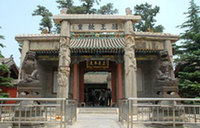"Juniors and seniors are taught in Chinese, but tutorials are given, after class and in Tibetan, at the students' individual requests," he says.
Upon graduation, the students are required to pass Tibetan as well as Chinese language proficiency tests, he says.
The school has obtained more than 40 sets of Tibetan-Chinese bilingual textbooks covering arts as well as science to ensure students are well-grounded in both languages.
Meanwhile, the Chinese central government and Tibet's regional government have invested more than 1 billion yuan ($163 million) since 2008 to boost technological application of the Tibetan language, including the development of Tibetan-language office software and digital dictionaries.
Last year, the first Chinese-Tibetan bilingual smartphone went on the market in Lhasa, capital city of Tibet. The phone was jointly developed by the country's technology firm Huawei, China Telecom's Tibetan branch and the University of Tibet. It allows Chinese and Tibetan input and supports many Tibetan-language applications.
"Tibetan is a unique language, colorful and explicit," says Yeshi Soiba. "For example, there are different names for calves aged from 1 to 7. To know the language will help you understand the Tibetan culture and people."























 Raymond Zhou:
Raymond Zhou: Pauline D Loh:
Pauline D Loh: Hot Pot
Hot Pot Eco China
Eco China China Dream
China Dream China Face
China Face





